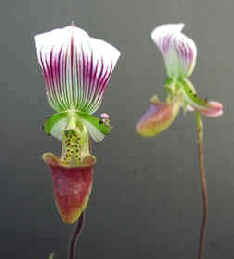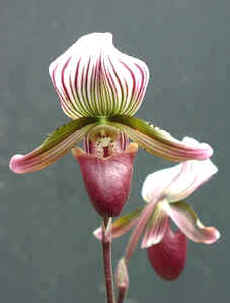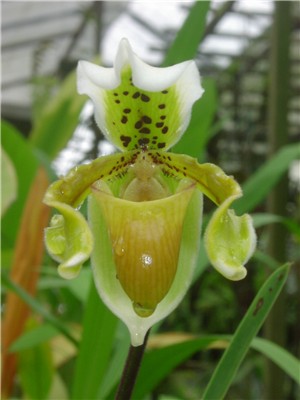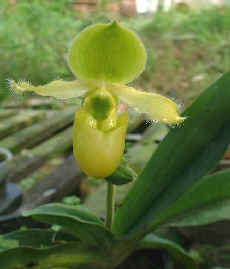

Like many Paphs, it has warts and hairs on the flowers which mimics aphids, thus attracting the Syrphid flies, its pollinator in the wild.








Paphiopedilums
兜蘭
Paphiopedilums (or slipper orchids) have been one of the most revered ground orchids and for many years, have been collected in the wild to supply hobbyists world-wide. Unfortunately, many of them have become very rare and it has been said that many wild collected species do not do well in cultivation. Even if that be true, who will want to spend US$30 to get a TC Paph niveum when the markets at Thailand sell them for less than a tenth of the price, blooming ?
My interest in these plants is mainly due to the fact that it is a real challenge to grow them well. In fact, these plants are so picky its hard to believe they can survive so well in the wild. They need very well drained medium - many of them actually dangles from near vertical cliffs in the wild; however, they cannot be treated like a succulent and be deprived of water. The shape of the leaves also mean that water can be easily trapped at the crown, causing rot. Many of them lives in mountains that are cool, moist yet relatively windy, an environment which is hard to replicate in lowlands. During hotter months, they are very susceptible to spider mites. They are also slow growing, and growing from seedlings is really a test of patience. Even though they have very unique bloom, most people I know scores only for the hardier species like niveum, concolor and callosum (which are quite free flowering). One also need to be knowledgeable in buying plants - spending a fortune to get a good clone of P. lowii to grow in the lowland will only cause pain and despair to see the plant suffer and expire eventually under the tropic heat. Well, what I am trying to say is, its not a plant for novices, and since its so rare in the wild, if you do not have confidence in growing them, don't. Alternative;y, grow the hybrids first, they are usually much easier !!
|
|
P. appletonianum is from Southern China (Hainan) and Indo-China. It is a cool grower but surprising my plants are able to blooom under the lowland heat for 2 seasons already. |
|
|
Paph
rothschildianum is known from only one remaining lowland location in
Mount Kinabalu, East Malaysia. Fortunately, the plant has been tissue
cultured in fairly large quantities over the years and is not uncommon
in many serious hobbyists' collections.
Like many Paphs, it has warts and hairs on the flowers which mimics aphids, thus attracting the Syrphid flies, its pollinator in the wild. |
|
|
Paph callosum is very closely related to Paph barbatum (below). The most apparent difference is the much broader dorsal sepal and as shown in this photo, the petal normally sweep backwards, although I have seen forms which do not. This species is more northerly than barbatum but along Thai-Malaysia border their range overlap. |
|
|
Paph barbatum is from West Malaysia, being found on mid-altitude to montane regions. There is an opinion amongst some that callosum is merely another form of this species. |
|
|
P. gratiaxum from Indo-China. This is a cool grower with long, stiff uniformly green leaves. Surprisingly, the form I have flower and grow well in the lowland once established (which took 9 months). |
|
|
P. exul is closely related to P. gratiaxum but is more heat tolerant. It has much narrower leaves. |
|
|
Paph sukhakulii is a cool grower described in 1964 from type specimens in Northern Thailand. It has nice tasselated leaves and distinctive flower but unfortunately does not do well in the lowland. |
|
|
An example of Paph which can be grown in the lowland is P. niveum from Thailand and N. Malaysia, which I grow on cleaned free-draining coral grannules and a bit of peat. Closely related species, like the yellow P. concolor is also suitable for lowland cullture and are the most commonly grown species in this region. |
|
|
The
original Paphiopedilum primulinum var concolor known to science was
found in Gunung Leuser in Java. This is one of the several
Paphiopedilums discovered by the late Indonesian Chinese Liem Khe Wie,
known also by his local name Kolopaking. According to record, the path
to its discovery was very treacherous, one of his companion was killed
by a venomous snake and they had to ward off a giant python before
finding this yellow flower growing on a slope - quite an adventure !
|
|
|
Paphiopedilum primulinum var violascence is more suitable for lowland culture and is one of the best bloomer for me. |